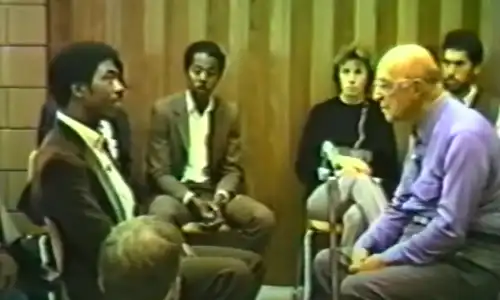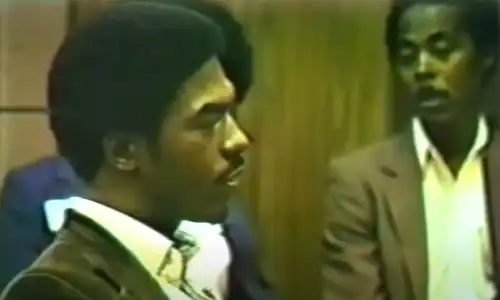THE PSYCHOTHERAPY OF CARL ROGERS:
INNER WORLD
BY WILL STILLWELL
INNER WORLD
The subjective human being is of primary importance and value for Rogers. As he describes it, each person lives from an “inner world, a life from which we’re generally excluded.” This private, psychic, self-world is formed through a person’s experiences and her attempts to make sense of those experiences.
Here is where Rogers locates the “psychological problems” a client may be experiencing as anguished and confused discontinuity between how she wants to be or should be and how she finds herself behaving or feeling.
Rogers understands himself in the therapist role as giving permission to the client to be as she authentically feels herself. Rogers understands himself as responding to the client’s (initiated) communications. How does my conduct receive her?
Here are some examples of Rogers moving with the internal world of his clients:



Rogers works to get right with the clients’ meanings, including a challenge to Rogers’ statement as with Steve here, or even when client meanings are about Rogers himself, as is the case with Dadisi and Richie here.
Through non-interference, Rogers is an acute master of interpersonal sensitivity. He is sensitive to a person’s developing edge of feeling or thought or gesture; or, stated differently, sensitive to one’s awareness in one’s own becoming. Rogers wants not to guess far in advance of a client. Inducing a client’s potential that Rogers might anticipate or wish to explore might ruin the client’s sense of self-agency in this interpersonal process. Here in this interaction, what? how much? which direction? is the client moving to know?

But I find a counter-example. In this segment early in the interview I see Rogers seem to anticipate what Philip will address, and not respond to his client’s emotionally-charged details. Philip speaks of feeling fearfully frozen as well as brave following his encounter with a menacing strange man. It seems, Rogers has earlier heard “death” when Philip softly-spoke the word “depth.”

One important theme I witness emerging in this interview is Philip attending to his own “little things” that are (to him) “inappropriate and immature.” Rogers consistently bypasses these details for grander patterns that he senses from Philip. (Following their interview, Rogers comments to Philip, “The only thing you experienced was this glow…and that didn’t have too much to do with the words.”) But while in this therapy together Philip has noticed his and Rogers’ mutual partial discontinuity, and comes to experience self-acceptance and celebrate his own preference.

In this sequence Rogers has honored what he calls the “working silences” of his client. Rogers said that in an interview “after I’ve responded to your comment and there’s a pause, it’s yours.” It’s not jointly their silence, or Rogers’ silence, the silence belongs to the client.

Rogers summarizes from the comment Steve has made, that Steve is content to be in his interview now “without expectations,” but that brings a further realization to Steve. Steve sits quietly for a minute. And, most essentially as we can see, Rogers stays with him there. Steve does not distract himself from whatever it is that he is experiencing and thinking. A few minutes later Steve says he is “trusting” and “calmer.” Rogers facilitates individuals to learn – to re-respond and re-assess their life circumstances in light of their trusting new information from their own experiences.
Rogers’ personal practice of life, and his professional practice of therapy, encompasses an experiential learning perhaps influenced by John Dewey’s philosophical ideas. “Experience for me is the highest authority,” Rogers asserts.
Importantly, he asks of the experiencing person: What might this mean for me, about me, here?
Hearing myself in my inner world, will I test the echo for my integrity in the social world?
Guided by a totality of experiencing — feelings, memories, perceptions – he seeks for himself and his clients a manner of self-composing, an “inward ordering of significant experience…and meaning.” He is quite aware that for the learner, self-awareness without self-deception and distortion sometimes involves painful personal psychic reorganizations.

We can see him here with Steve as Steve experiences associations, ideas and meanings for himself.
Rogers’ openness to what the client chooses is never an unlimited comprehension or tolerance. Commentators have pointed to Rogers’ specific commissions and omissions in taking up a client’s indications of his inner world. Some believe this shows Rogers’ subtle (and perhaps unconscious) direction-setting for the client’s behavior or topics of concern.
Carl Rogers does have a vision – convictions and hopes and predictions about who/what people can be.

Many clients, like Richie in his interview, are reluctant to accept the positive feelings for them that other people manifest. (Remember we’ve seen Richie confessing he is “in awe” of Rogers.) In this sequence, Rogers notices Richie’s forward–moving self-enhancement.
Rogers has stepped out of our commonly-held basic assumption, that interpersonal relations are, at base, conflictual. In these encounters he is essentially non-judgmental in regard of the other person and, importantly, in his own self-consciousness. He does not put himself “over-against” the other person. This results in a non-threatening, friendly appeal to the “over-against” qualities of the client’s self. Rogers trusts the “forward moving process of life itself…a person’s deepest tendencies make for his own enhancement and that of other(s)…”
Rogers certainly does not respond equally to all features in a client’s statements. Both Dadisi and Philip lay out all their concerns in the first 5 minutes of their respective interviews. But Rogers doesn’t hear it all; rather, he is the responding self who is here. Proceeding from mine, how do I arrive at your feelings of living? Rogers seems to express what he can relate to in the client, in the way he can relate in his present connection (here), and understanding (now).
I suggest that this is not a primarily moral, tactical, or philosophic stance, but presence with a person and no desire to be or go elsewhere.
As a client, I may have been missing, absent, even avoiding real presence. I cannot find a place to stand amid my internal fantasies or an external chaos. Maybe I have learned from my experience that some emotions or sensations or memories or thoughts will be physically painful or disordering or confusing.
Will I be safe, is my living body safe for me? Maybe my thoughts or my urges are dangerous or evil, maybe I am tempted to violate social or personal standards. If who I am or who I want to be is afraid of my truthful exploration of these issues, I may choose a kind of anonymous, separated, alienated freedom.
Here are Dadisi and Rogers, early in their interview.

How does it seem to you in this example? Is Rogers inducing or directing Dadisi to his “mad?” Are Rogers’ suggestions of “unfair,” or “frustrating” leading Dadisi?
Rogers is listening for something a client may be a little afraid to say directly.

Ten minutes further on in the interview in the next clip…Here we may witnessed a shift in Dadisi’s expression of his experience from ‘comfort’ to ‘puzzle’ to ‘fearful.’

In the following example, Steve speaks of his meditative practice; listen to what Rogers picks up. “I think of anxiety as being a positive step towards therapeutic growth…just through this thin membrane is something…not seen and not known and…frightening… At least in therapy…if you can let yourself into it, you’ll discover it isn’t so bad after all.”

Among these interviews, this one with Dadisi I believe shows Rogers at his most vulnerable. Again this segment – does Rogers strike you as vulnerable?

In his post-interview comments Rogers tells of his identification with Dadisi engaged against injustice, “I’m a rebel too.” And “I really appreciated…” your [Dadisi’s] trust. Yet in my sense of these remarks, Rogers seems to seek confirmation from Dadisi, as if he were to say, ‘does my acceptance of you as a black man come through?’ Throughout their interview, as in this segment we’ve seen from other angles, Dadisi has used language that express his sense of ‘injustice.’ Rogers adds the ‘feeling words.’

Rogers seems very engaged, yet an audience member following the interview asks Rogers about his seeming lack of emotionality. Rogers speaks of himself and empathy, his empathy – an understanding of the other person through the tangle of emotions and feelings that people know, and don’t know.
The “real problem” of missile sites in the German woman’s back yard seems to Rogers in his comments more “situational,” outside his purview of a psychological problem. But it is part of this woman’s “internal world.” Especially as experienced emotionally, “internal world” associations of meaning encompass “real world.” Had Rogers sometime asked for empathy concerning his own “real” problem of missile sites in his backyard, I hope his therapy partner could enter this “inner world” as-if it were her own.
Rogers speaks to a client’s “feeling.” Feelings for Rogers are not the same as emotions. Emotions we often think of as ‘happening to us from an uncontrollable source.’ Feelings are a person’s experiences as he touches on emotion and meaning together. They are essential and valuable experiences of our human being.
“Emotionally-tinged personal meanings” are internal, psychological and somatic events. They are the integrative category of experience bringing a person’s body into intimate contact with his mind. The potential dichotomy of experience (emotion, body) and meaning (mind, word) is subsumed in Rogers’ concept of feelings; “…rather than being in control…one becomes a participant in and an observer of the ongoing process of organismic experience.”

Rogers encountered many clients who subordinated or separated their body sensations to propositional ideas or ideals of themselves. That may be what Philip senses about himself, as we listen to him again in repetition. Do you hear this any differently this second time?

“The feelings we’re most uncertain about are often the ones most likely to be fruitful.” “Listen to the plain feeling and respond to it,” Rogers advised a therapist. He seems to feel his way into present living, “my owned feelings are in immediate interaction with those of the other.” Here, Rogers applies “feeling” to Ritchie’s statements, and sums together what he understands as Richie’s gathered attitude.

At first Steve seems to struggle to be in the interview. As I watch and listen, Rogers joins the dance of Steve’s inner world, a process as it moves from momentary feelings, to expressed issues, to doubts. Surging, fleeting and fleeing, growing, carrying forward, losing, exploding and on — allow presence for whatever is living, then patterns and motifs emerge — and client and therapist can become a life-dance together.
Rogers’ method is to follow the client’s process of being and presence. Rogers’ experience has convinced him that every individual person is in a process of maturation. We grow from our own fantasies, and from our meetings with objects and other people; our “self” is not really a noun — a thing arrived-at — self is a process of becoming. “The goal toward which maturity moves in an individual is being becoming, or being knowingly and acceptingly that which one most deeply is.” “ His deepest tendencies make for his own enhancement and that of others.”

Interviewing Philip, Rogers doesn’t follow up the stories in the numerous metaphoric examples that Philip uses to tell about himself (except the one that Philip tells of giving blood). To me he seems to focus on ‘Philip the person,’ a personal phenomenal aspect of any of the episodes of this interview; a focus on Philip’s “being.”
In comments he makes after this and other interviews Rogers says something similar to, “I don’t remember the content but I know we moved.”
He is not extracting data, he is immersing himself in the flow or stasis.

Once he is present, it is unusual for Rogers to go outside an internal world of his client. Here seems one exception as we return to this example at the end of his extended interview with Steve. Rogers seems less present as he first chooses to respond verbally to Steve’s verbal message and not explicitly acknowledge Steve’s cry.
Steve in turn responds to Rogers’ verbal content, cries again, then Rogers makes a seeming outsider observation about ‘emotion.’ Steve says he doesn’t understand this feedback and they work their way along from there. My guess is that here Rogers is attending to his own concern with a time limit to bring the session to a close; before again choosing to be with Steve.
Rogers’ facilitative relationship-style of psychotherapy has been categorized as a kind of “ego” psychology. I accept that characterization insofar as he often is accompanying a client toward the client’s adequate sense of logos – the client’s own wrestling with their decisions and intentions for greater awareness, influence and responsible agency over life happenings, moral clarity, constructive living, articulation, and order.
Rogers considered the greatest challenge to his therapeutic approach was from people brought to therapy but not consciously desirous of the therapist’s help.
Rogers is here, physically present. He is also here present time. In transcribing these interviews, I was surprised to notice that Rogers overwhelmingly speaks in the present tense (as designated grammatically in English). “What I am and what I feel” is set in present-progressive time. (Or as Moshe Greenberg calls it, “present affective tense.”)

In the following example, Philip speaks grammatically in the future tense and in the present-perfect tense, the latter signifying “continuing generalized idea or ideals of self” or “as it always is.” Rogers’ response mirrors this indefinite present-perfect and then, shifts to his description of what he hears of the client’s present.

Rogers is mostly in present as shown by his verb-tense with all four of these clients. Here he points to his surmise of the present implications of what Philip says.
Both Rogers and his client Steve speak mostly in the present tense. Rogers verbally raises his present-perfect being with Richie and Philip who (along with Dadisi) are largely self-referencing in generalized present. Whatever the four clients are telling Rogers about themselves now, or “always,” or themselves as participants in their pasts or futures, in his language Rogers is largely responsive by bringing their “now” “here.”
Rogers’ form of partnership is evident in several additional features of his verbal contributions. First, with a client he does not use psychological typology language. Such use could imply Rogers assuming a position superior by referring to the other person in specialized, abstract terms. He seldom asks questions when he may not understand the meaning of a client’s narrative (except when he does not hear what the client says). Asking another person a question about his meaning in effect requests him to change his communications in order to fit into the questioner’s understanding style. Rogers often makes statements about what he does understand (cognitive and affective “feeling”) from his clients; this action is free of his own moral approbation or condemnation, and seems to open up room for the client to be more expressive in expanding his own meanings.

In the four interviews under consideration Rogers in a way takes-on the self of the other person, by expressing in his own first-person language what he understands the clients’ meaning to be: he speaks ‘I’ as a way to manifest the client’s thoughts and emotions. Here is an example with Richie a few minutes into their interview.
Rogers “switches” to this mode for all or part of one-sixth of his occasions at speaking. He speaks these “switches” mostly in present tense verbs connoting “feeling” or “saying.” Sometimes they appear as a tentative implicit question: “Is this that I’m touching what it’s like for you?” and sometimes as a statement: “This is what it’s like to be me” said for the client. On no occasion in these interviews do I see a client understanding Rogers’ self-embodiment-as-the-client either as a reference to only Rogers himself or a violation of the client’s own standing.
Rogers characterizes therapy for the clients as discontinuous change, “lots of preparation” punctuated by “moments of movement.” Movement he apprehends as “immediate experience in a new self-acceptance and integration… “unified, and completely experienced and accepted…” “a total experience” embodied “in the moment of relationship with another person.”

Here well into their interview we see just that, as Philip describes the present state he has come to in the interview, the “glow,” “being filled…in the whole of me.” Rogers affirms a similar description of Philip’s presence, and moments later Philip adds to his description of his experienced self-acceptance.
Rogers says real movement takes place where their relationship is experienced as a kind of reciprocity: “I see him as he is and he really senses my understanding and acceptance of him.”

Here, from perhaps the last recorded interview he made (video of poor quality and not one of those we’re examining here) we can see Rogers hold hands with a trembling client. “I trust my intuitive feelings when something wants to be said.”

Previously we watched Steve and Rogers working toward a meaning-and-emotion-laden term to describe certain of Steve’s relationships. After one exploration, here Steve returns to his terminological moment of reference in order to move again in a satisfying way.

As mentioned earlier, the clients Philip and Dadisi spell out in their first five minutes all the issues they will work on in the interview. But at the end, they have moved, they have experientially more completely accepted themselves through another person’s (Rogers’) particular company. Philip comments on how it seemed to him.
Movement of feelings for Rogers and the client are not necessarily the same. Russell Walsh upon retrospectively examining particular moments of movement during therapeutic sessions, has found that some of the same moments are identified by both client and therapist as pivotal, but that meanings of the movement differ for each of these participants.
